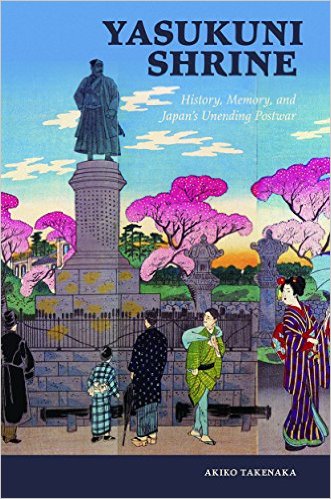Yasukuni Shrine: History, Memory, and Japan’s Unending Postwar by Akiko Takenaka
published by the University of Hawaii Press and in the Studies of the Weatherhead East Asian Institute, Columbia University Press.
 Book description from the Press:
Book description from the Press:
This is the first extensive English-language study of Yasukuni Shrine as a war memorial. It explores the controversial shrine’s role in waging war, promoting peace, honoring the dead, and, in particular, building Japan’s modern national identity. It traces Yasukuni’s history from its conceptualization in the final years of the Tokugawa period and Japan’s wars of imperialism to the present.
Author Akiko Takenaka departs from existing scholarship on Yasukuni by considering various themes important to the study of war and its legacies through a chronological and thematic survey of the shrine, emphasizing the spatial practices that took place both at the shrine and at regional sites associated with it over the last 150 years. Rather than treat Yasukuni as a single, unchanging ideological entity, she takes into account the social and political milieu, maps out gradual transformations in both its events and rituals, and explicates the ideas that the shrine symbolizes.
Takenaka illuminates the ways the shrine’s spaces were used during wartime, most notably in her reconstructions, based on primary sources, of visits by war-bereaved military families to the shrine during the Asia-Pacific War. She also traces important episodes in Yasukuni’s postwar history, including the filing of lawsuits against the shrine and recent attempts to reinvent it for the twenty-first century. Through a careful analysis of the shrine’s history over one and a half centuries, her work views the making and unmaking of a modern militaristic Japan through the lens of Yasukuni Shrine.
Yasukuni Shrine: History, Memory, and Japan’s Unending Postwar is a skilled and innovative examination of modern and contemporary Japan’s engagement with the critical issues of war, empire, and memory. It will be of particular interest to readers of Japanese history and culture as well as those who follow current affairs and foreign relations in East Asia. Its discussion of spatial practices in the life of monuments and the political use of images, media, and museum exhibits will find a welcome audience among those engaged in memory, visual culture, and media studies.
10 black & white illustrations. 296pp. July 2015. ISBN: 978-0-8248-4678-7.
Table of Contents:
Introduction
Mobilizing Death: Developing the Myth of Yasukuni
Institutionalizing Joy: Turning War into Spectacle at Yasukuni Shrine
Networks of Grief and Pride: Yasukuni Shrine in Regional Japan
Institutionalizing Grief: Yasukuni Shrine and Total War
Who has the Right to Mourn? Politics of Enshrinement at Yasukuni Shrine
Mobilizing Memories: Postmemorial Conservatism at Yasukuni Today
Epilogue: Contesting Memories: Yasukuni Shrine as a Countermonument
Author information:
Akiko Takenaka is associate professor of Japanese History at the University of Kentucky.

Interesting, I guess there are different sides to any story. Every country remembers its war dead….
It’s certainly true, Hugo, that every country remembers its war dead. However, there’s a big difference between making the remembrance an occasion for nationalism rather than an opportunity for reaching out to others and asserting a common humanity.